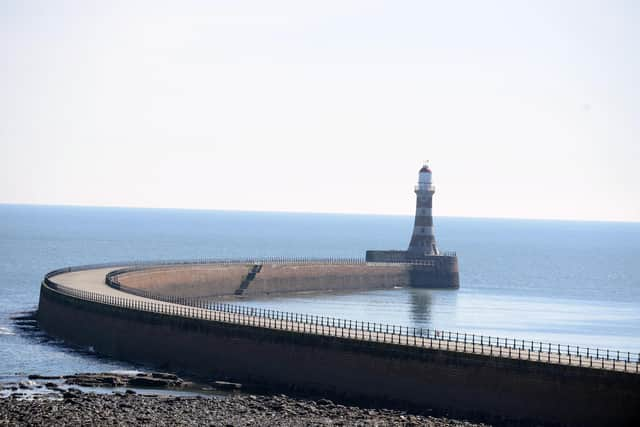Sunderland's greatest ever April Fools' joke, when thousands turned up to see a man 'walk across the North Sea'
and live on Freeview channel 276
In her book, Portraits of the East End, author Sharon Vincent tells of times past when April 1 on Wearside involved far more spectacular pranks than today.
Sharon’s book tells of an incident on April 2, 1868 when leaflets were circulated in what is now Sunderland, announcing that Professor de Grieves from Havre in France would walk a mile across the North Sea to demonstrate his “patent Kamptulicon boots”.
Advertisement
Hide AdAdvertisement
Hide AdHad the event been scheduled for April 1 people would have smelled a rat. Nevertheless, staging it on April 2 seems decidedly underhanded; even if it was funny.


Echo readers scarcely need reminding that “Kamptulicon” is derived from the Greek words “kamptos” (flexible) and “oulos” (thick).
Sharon wrote: “It was the trade name for a new type of cork and rubber floor covering – the forerunner of linoleum – which when launched in 1862, caused a sensation.
“It was warm, easy to clean, water resistant and deadened noise. Perfect.”
Advertisement
Hide AdAdvertisement
Hide AdPeople fell for the practical joke largely because an apparently genuine and very similar event had taken place around 30 years earlier in the same place.


In presumably about 1838 a “walking on the sea” event was staged off Sunderland’s piers, apparently also attracting thousands of spectators, although details have been lost over time (there was no Sunderland Echo until 1873).
Back in 1868, thousands of people believed the feat was to be repeated; if indeed it had happened a first time. People’s memories dictated that it had taken place, so that was that. Nowadays this is known as proof by repeated assertion; if something is said often enough, it becomes “true”.
Anyway, an estimated 10,000 people gathered at Sunderland’s piers “to find a good vantage point before the start time of quarter past one in the afternoon”, wrote Sharon.
Advertisement
Hide AdAdvertisement
Hide AdBy 12.30pm the piers, beach, dock and promenade were rammed with curious onlookers. Perhaps they were on a half-day at work. The North and South piers were crowded with curious people.


Sharon wrote: “Anywhere that gave a decent view of the piers and the sea beyond was densely packed with spectators.
“It was estimated that no less than ten thousand people were waiting at the mouth of the river for the professor and his pair of Kamptulicon boots.
“Beyond the piers, a steam tug heavily overloaded with passengers, had seized a business opportunity and charged sixpence a head for the unique privilege of a sea view of the professor.
Advertisement
Hide AdAdvertisement
Hide Ad“Smaller craft of all kinds had also put to sea, waiting for the appearance of the man himself in order to accompany him on his ‘mile out to sea.’ Everyone on land and sea continued to wait patiently as the minutes ticked by.
“By 1.45pm, half an hour after the allotted time, there was still no sign of the professor. Gradually, realisation dawned on the onlookers that they’d been fooled.”
As disappointed crowds on the South Pier shuffled off home “their disillusion was compounded by a comment chalked on a blackboard near the Graving Dock gates – “APRIL FOOLS!”
The Sunderland forerunner
Dates are uncertain, but about 30 years earlier on April 1, about the same time as the “genuine” water walker did his thing (we assume it was a man, women are far less likely to attempt something this dim), another large scale April Fools’ joke was carried out in Sunderland.
Advertisement
Hide AdAdvertisement
Hide AdThe story goes that it was also Easter Monday (which would make the year 1839), so most people were off work. A man was purportedly going to perform a dive from the old Wearmouth Bridge into the River Wear.
This also attracted thousands of onlookers. Such a hair raising feat had never been carried out before. It wasn’t about to be done then either.
Sharon says: “The ‘diver’ never turned up and thousands of townspeople had wasted the day hanging around the bridge, victims of another April Fool’s Day prank.”
Other great April Fools
Other great historical April Fools’ japes include the famous Panorama hoax on the BBC in 1957 when broadcaster Richard Dimbleby (David and Jonathan’s dad) reported on “an exceptionally heavy spaghetti crop” growing from the spaghetti trees of Switzerland, late March being “an anxious time for the spaghetti farmer”.
Advertisement
Hide AdAdvertisement
Hide AdPasta was not particularly common in 1950s Britain and millions of viewers fell for it. In response to requests for more information on spaghetti growing, the BBC advised “place a sprig of spaghetti in a tin of tomato sauce and hope for the best”.
On April 1, 1977 the Guardian newspaper’s travel guide extolled the virtues of the San Serriffe islands. Its two main islands, Upper Caisse and Lower Caisse made a geographical outline in the shape of a semicolon. They love a type-face related gag at the Guardian.
On April 1, 1998 a Lisbon radio station announced that Iran had withdrawn from that year’s World Cup and that Portugal, who had failed to qualify, would be the replacement nation.
The result was impromptu street parties, people riding the street on the tops of cars, waving the national flag and general euphoria.
Advertisement
Hide AdAdvertisement
Hide AdNow that, along with mugging 10,000 people into gathering needlessly at Sunderland’s piers, is what we call an April Fool.
So much better than today’s tame efforts: Mars Bars for the left-handed, spectacle for pigs, etc.
:: Very many thanks to Sharon Vincent for getting in touch with the Echo.